Let's face it: Nobody wants a TSA agent rifling through their bags. So, we're sharing the top checked bag restrictions and regulations to save time on your flight.
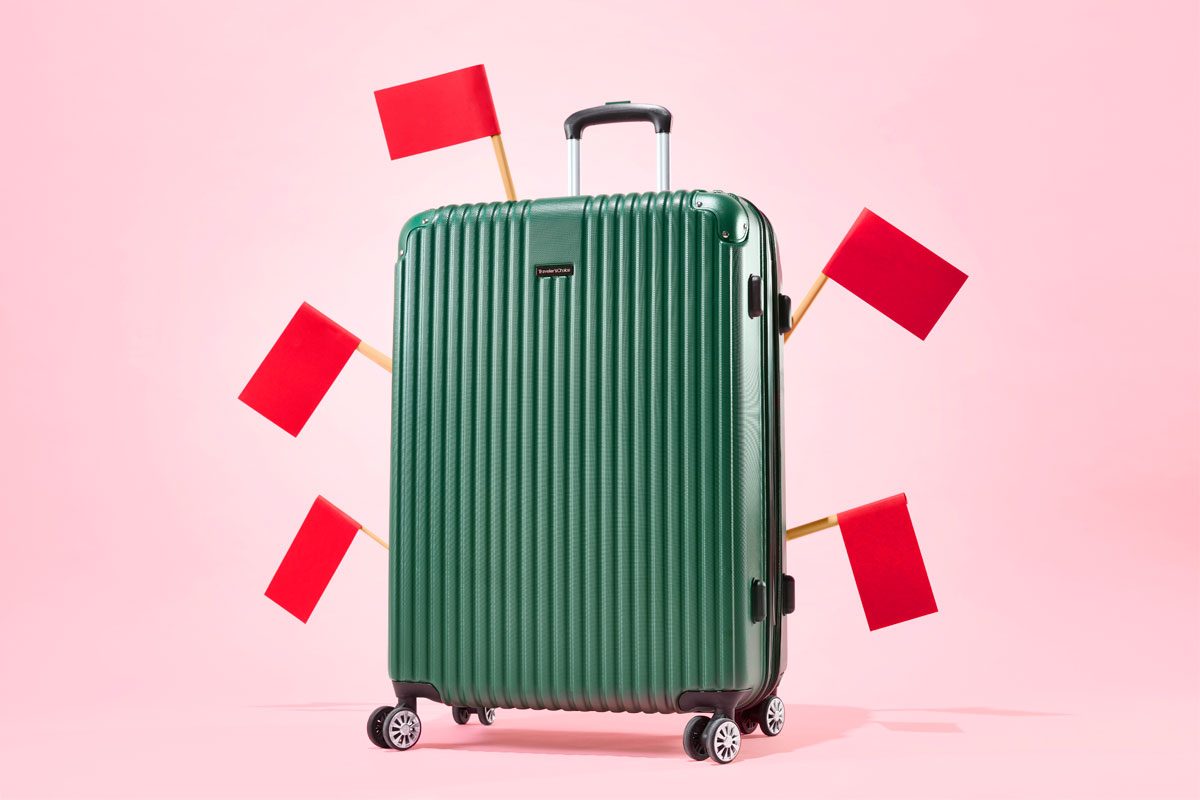
16 Items Banned by the TSA’s Checked-Bag Restrictions

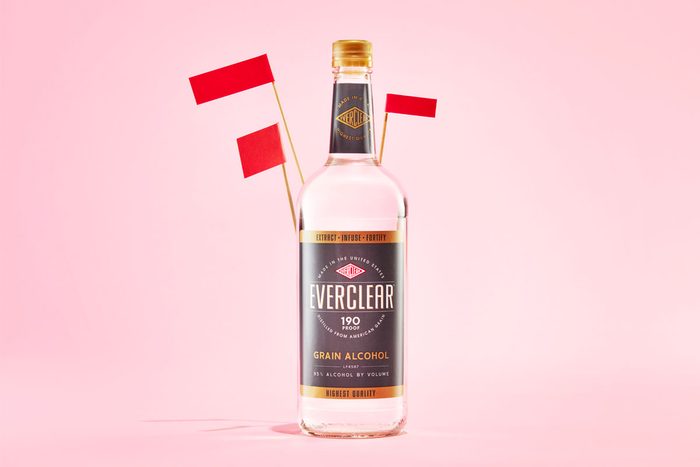
High-proof alcohol
It’s OK to pack most alcohol, whether it’s wine or hard liquor, in checked luggage, as long as it is in its unopened retail packaging. But one of the prohibited items in checked baggage includes anything over 140 proof (70% alcohol) because it’s more flammable. King of Spirits Gold Absinthe is a strong liquor that’s 140 proof, while other types, such as John Crow Batty Rum, Everclear and Golden Grain are over the allowed amount. Standard wine, hard cider, saké, tequila and vodka are a few alcohol types that typically fall under 70%, but always make sure to check! Also, don’t make the travel mistake of packing an entire case of that amazing Napa or Sonoma wine: The FAA restricts each passenger to five liters (1.3 gallons) of alcohol.
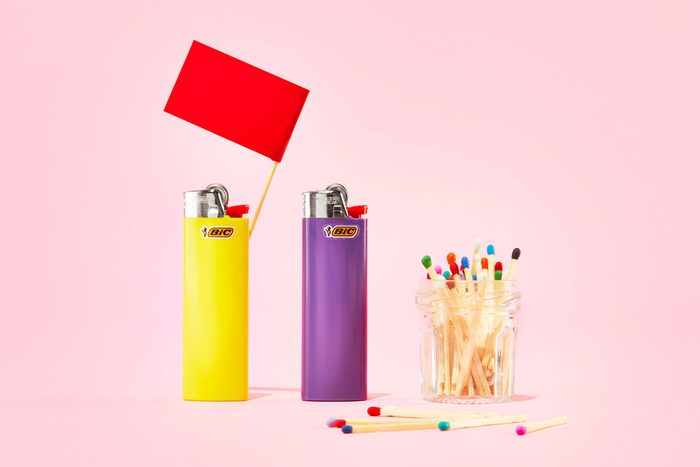
Lighters and matches
Can you bring a lighter on a plane? The answer is short and simple: The only lighters permitted in checked luggage are those without fuel or those contained in a Department of Transportation–approved case, also called a DOT case. In carry-ons, however, you’re permitted to bring one lighter or one packet of safety matches. Take note: Matches are not permitted in checked bags at all, though, and strike-anywhere matches are forbidden anywhere on a plane. So whether you need them to light a scented candle to help you relax or to indulge that habit you’re still trying to quit, it’s best to bring these items in your carry-on bag.
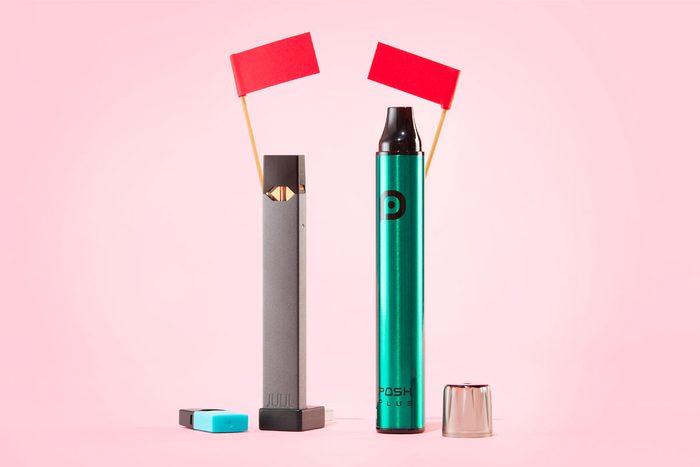
E-cigarettes and vapes
These cigarette substitutes are not allowed in checked luggage under any circumstances because they contain lithium batteries, which are flammable. Additionally, should a lithium battery spark a fire, it is more easily extinguished in the cabin of the aircraft. So stash your vapes in your carry-on bag, but check with your airline to see if it restricts the number of devices you may bring.
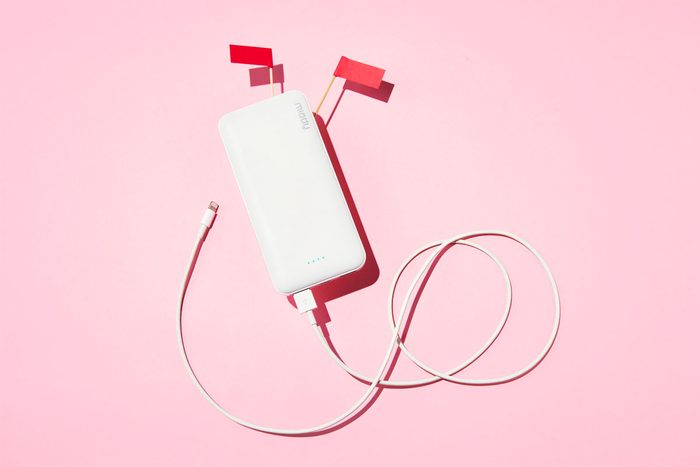
Lithium batteries
Speaking of explosives, these types of batteries have been known to explode mid-flight, so they’re now prohibited unless they’re contained in a device that offers protection. That means you can pack an electronic toothbrush or a camera that contains a lithium battery, but if it’s just a pure battery—like a power bank used to charge cell phones, or a spare laptop battery—it needs to go in your carry-on bag. To note, this type of battery is often used in smart luggage with built-in charging ports. If your suitcase has this feature, you’ll need to remove the charger before you check your bag. Here are other electronics that contain lithium batteries:
- E-cigarettes
- Laptops
- Smartphones
- Tablets
- Cellphones
- Digital cameras
- Game controllers
- Smartwatches
- eReaders
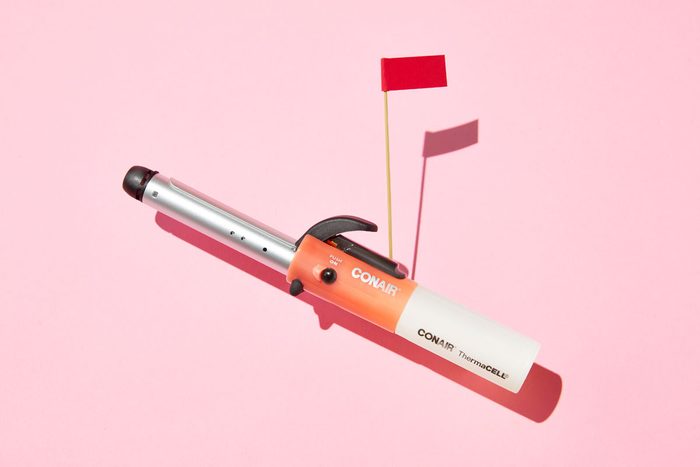
Cordless curling irons
These contain a butane-powered cartridge, which is at risk of exploding mid-flight. Bring your old-fashioned corded curling iron instead. Alternatively, you can opt to store your cordless curling iron in your carry-on bag—so as long as there’s 1) a safety cover that’s securely fitted over it and 2) it’s protected from accidental activation.

Certain novelty items
Airport gift shops are filled with all sorts of novelty items, so be mindful of what you buy since some could look like grenades and other prohibited items. For obvious reasons, you may not want to buy these kinds of souvenirs, as they will definitely get you flagged for inspection. However, once the TSA determines that the object poses no threat, the item will be placed back in your bag—along with that little notice of inspection.
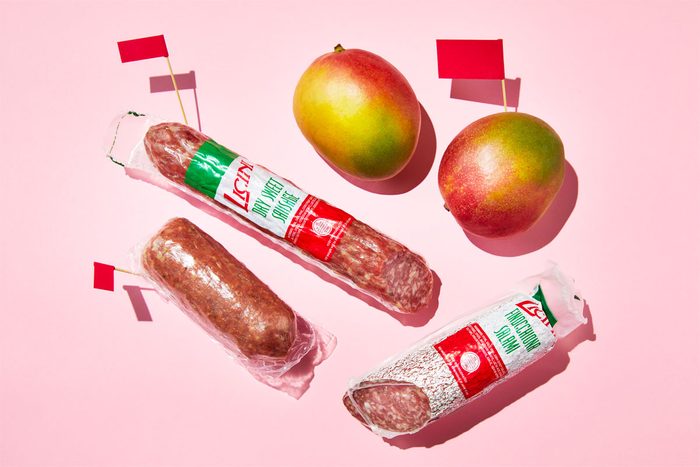
Meat and produce
If you’re traveling domestically, you can generally pack any food you want in your checked bag—as long as TSA can easily determine what it is. However, if you’re returning from a trip abroad, think twice before bringing home that amazing Eastern European salami or those juicy tropical mangoes. What’s more, says Charlie Neville, frequent traveler and chief marketing officer of JayWay Travel, “It’s a tragedy that some of the tastiest souvenirs you might want to bring back from Europe would get confiscated.” For example, he says, “Jamon Iberico, a pride of Spain, is very much against the rules, as are most animal-derived products.” What’s more, CBP prohibits the importation of most meat, fruits and vegetables to prevent the introduction of pests and diseases to the United States. So, before heading home, it’s a good idea to check with CBP to make sure your souvenir won’t be problematic.
However, if you’re wondering about coffee, TSA and Customs and Border Protection (CBP) agents won’t bat an eye if it’s in your checked bag. Sure, we’ve all heard the stories about people trying to disguise the scent of cannabis or other federally illegal drugs with coffee, so the TSA agents at airport security may give a carry-on bag with coffee a little extra attention, but when it’s packed in a suitcase, there’s no concern. So bring home those single-origin coffee beans, whether ground or whole, and enjoy the flavor of vacation in every sip.

Camp-stove propane canisters
Speaking of camping, you can’t bring this common but highly flammable fuel in your luggage either. However, if you acquire some propane canisters on your trip and use them up, you can safely pack the empties in your luggage to recycle or refill later. Alternatively, Carolin Fuller, avid outdoor traveler and director of partnerships at Campspot, recommends “buying fuel at outdoor stores near your destination or opting for a camping stove that uses canister fuel you can purchase upon arrival.”
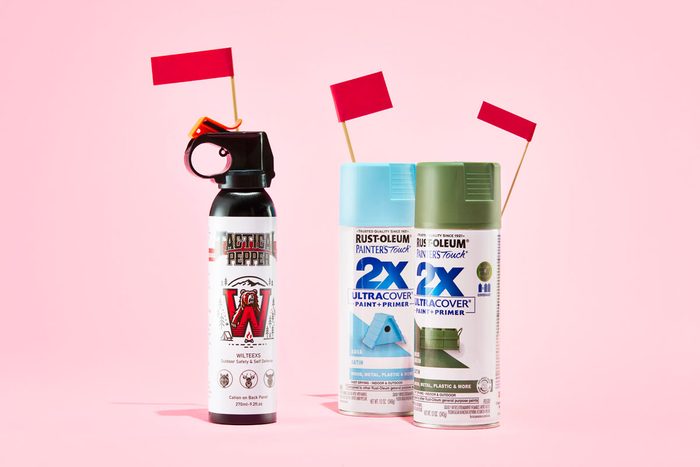
Aerosols and compressed gases
This includes things like fire extinguishers, spray paint, cooking spray, spray starch and bear spray, the latter of which Fuller describes as “a must for some wilderness areas.” However, many parks and local outfitters offer rentals. Similarly, “If you typically pack aerosol insect repellent, a solid repellent stick or purchasing a spray once you land is a better alternative.” All in all, she says, “A little planning ensures that you have what you need for your adventure while staying TSA-compliant.”
Wondering if you can bring hairspray on a plane, too? The answer is yes, since it’s considered a personal care item. Deodorants in aerosol containers are allowed as well—so as long as it’s under 3.4 ounces.

Ammunition
Go ahead and pack your (legal) guns in your checked bag—the TSA permits them as long as they’re packed in a locked hard-sided container and declared to the airline at check-in. When it comes to ammunition, however, the rules are a bit stricter, and if you don’t follow them closely, your luggage could get flagged.
The TSA and FAA both permit ammunition up to .75 caliber and shotgun shells of any gauge, but it must be packed in a box specifically designed for this purpose, and you must declare it to your airline. International regulations, along with some U.S. airlines, limit the amount of ammo you can travel with to 11 pounds per passenger. Other types of ammunition—including black powder, smokeless powder, primers, percussion caps or homemade powder and ball loads for muzzle loading—are all prohibited by the FAA.

Ammonia and bleach
Sorry, clean freaks—you can’t pack ammonia or bleach to sanitize that Airbnb. Buy it when you land so the TSA doesn’t flag your luggage. While neither one is flammable on its own, ammonia can be explosive when mixed with other chemicals, and bleach is considered an oxidizer, which can make a fire start more easily and spread more quickly. As a result, both are prohibited as hazardous materials.

Fireworks and sparklers
Leave the fireworks at home—they are, quite literally, explosives. Given how flammable they are, you can see why this could be a problem on an airplane. Fun fact: The TSA sees an increase in attempts to transport these every year around the 4th of July!
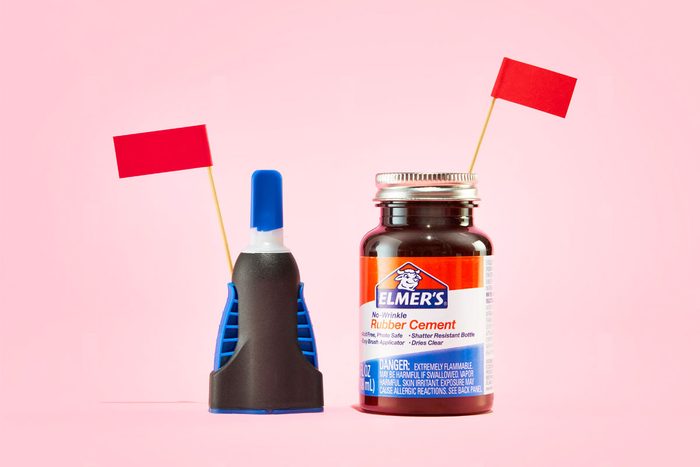
Specialty glue
While white school glue is fine, other specialty glues and pastes, such as model glue, rubber cement and some superglues, are highly flammable and therefore prohibited in checked bags. To see if the one you want to pack is flammable, you’ll want to check the product label or the manufacturer’s safety data sheet. Also, to really be on the safe side—and avoid having your bag flagged for inspection—just don’t pack glue.
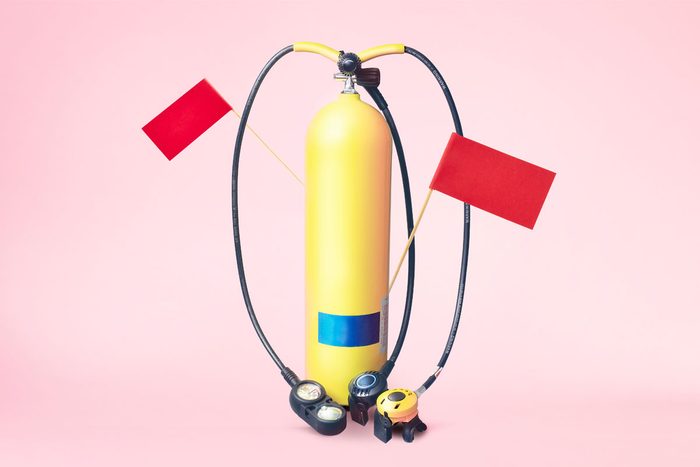
Pressurized air tanks
If you’re going on a big scuba vacation, it’s probably best to rent supplies at your destination. If you try to pack a pressurized air tank, your luggage won’t make it through TSA. According to the TSA website, “It must be clearly visible to the TSA officer that the cylinder is empty.”
Similarly, compressed or liquid forms of oxygen—including those trendy flavored O2 canisters marketed for use at high altitudes—are highly flammable and not allowed in checked or carry-on bags. If you need oxygen for a medical condition, you’ll need to pack a portable oxygen concentrator. Rather than compressing oxygen, this type of system separates ambient oxygen from nitrogen and other gasses in the air and delivers the oxygen to a user in a continuous flow.
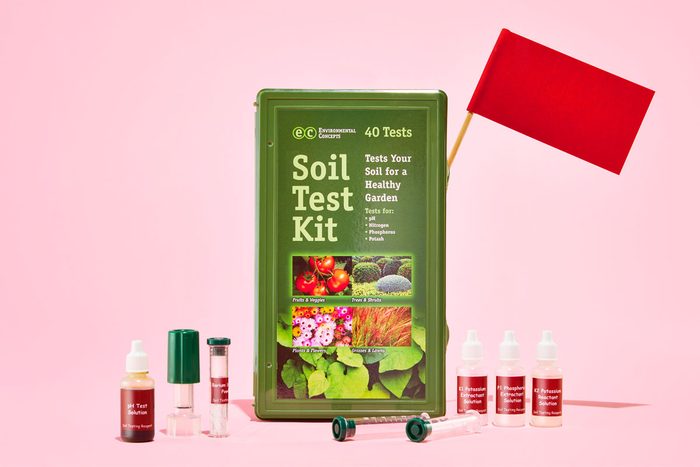
Chemical kits
These include kits for testing water or soil, as well as kids’ chemistry kits. Any chemicals that could explode—such as corrosives, oxidizers and organic peroxides—are banned from checked luggage as well as carry-on bags. So if you want to help your aunt test her soil before planting a garden, or you want to test the water quality at your vacation getaway, have these tests sent directly to your destination.
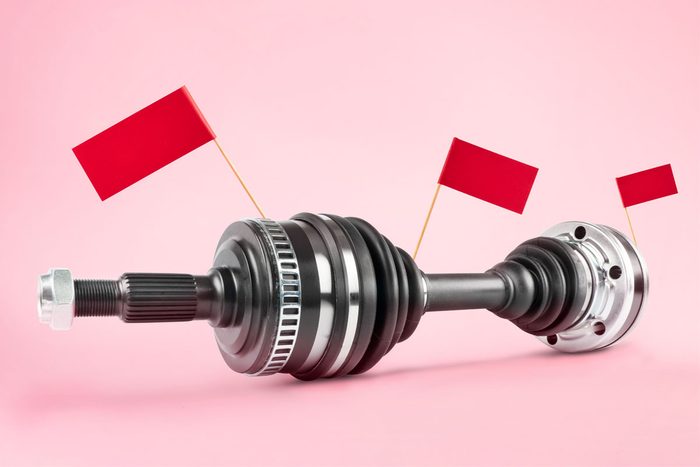
Car axles
Yep, the TSA has seen it all. Occasionally, people will pack a car axle in their bags. TSA agents will most likely open up your suitcase if they see this—or anything else they can’t visually identify—and swab for explosive residues. Once it’s determined that the item poses no threat, it will go back into your bag and be on its way to your destination.
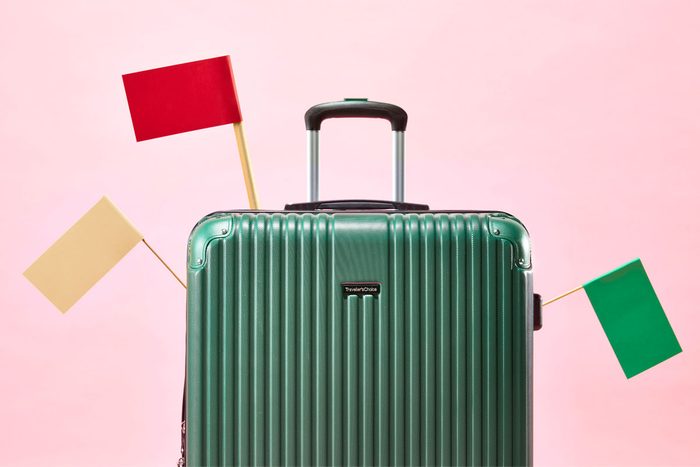
FAQs
What is allowed on a plane in a checked bag?
In general, TSA rules for checked luggage are much more lenient than for carry-ons, so you can pack everything from drinks and other liquids well over 3.4 ounces to certain types of weapons. That’s because at the security checkpoint, whether it’s the carry-on X-ray machine or the body scanner, agents are looking for anything that could be used to threaten the safety of passengers or crew members. With checked baggage, TSA agents are looking for something a lot more specific.
Agents can figure out what most things are using the TSA’s high-tech checked baggage inspection system (CBIS), which is equipped with an explosive detection system (EDS) that creates 3D X-ray images of your bag’s contents. Anything that’s potentially flammable or explosive will be removed. Items that agents are unsure about will be flagged for up-close inspection. In both scenarios, your bag will end up with a little “Notice of Inspection” tag on it.
Also, other agencies, such as the FAA and CBP, may have additional restrictions, especially with regard to fresh food items from other countries. With that in mind, below are some of the prohibited items in checked baggage that will get flagged by the TSA.
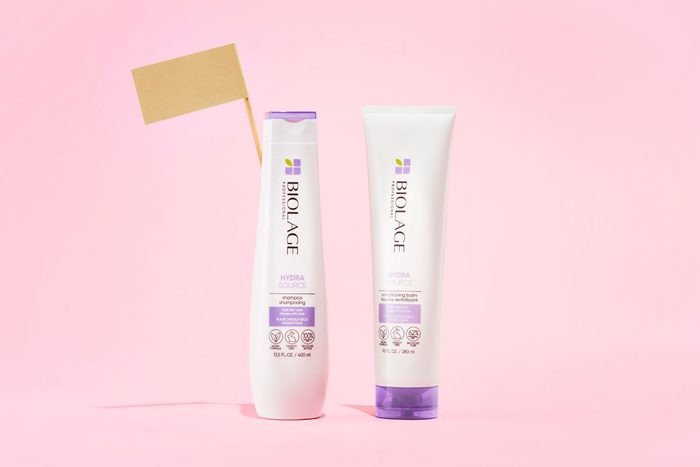
Can I bring full-size shampoo in checked luggage?
As noted earlier, there’s no rule for liquids (except for alcohol) in your checked bags. That said, just because you can pack your full-size liquid toiletries in your suitcase, it doesn’t mean you should. Baggage is not handled daintily, and no one wants to spend the first day of their trip washing the exploded bottle of body lotion out of their clothing. Besides, if those bottles are heavy, they may cause you to exceed the weight limit for checked bags.
Can you bring cigarettes on a plane?
While smoking is not allowed on board the aircraft, the TSA does permit travelers to bring cigarettes in their checked bag, as well as in their carry-on or actually on their bodies (like, say, in a purse or pocket). However, if you’re traveling internationally, be sure to check the customs guidelines of the country you’re visiting since most have limits on the amount of cigarettes you can travel with. If you do plan on bringing more than the allotted amount, you should expect to declare them at customs—and potentially pay a duty fee in order to keep them.
Is the TSA looking for drugs in checked luggage?
According to the TSA, the organizations’ screening procedures are focused primarily on security in order to protect against potential threats. As such, the TSA security officers don’t deliberately search for marijuana—or any other sort of illegal drug, for that matter. With that in mind, if something is discovered during a routine screening, law enforcement will then become involved.
What is the weight limit for checked bags?
The TSA does not set weight limits for checked bags, but airlines do. The maximum allowable weights vary by airline, and sometimes by status or type of seat purchased. Generally, they range from 40 to 70 pounds for both domestic and international flights. You can avoid overweight fees (or doing the last-minute shuffle of items from your luggage to your carry-on at the check-in counter) by using smart luggage that automatically calculates the weight of your haul as you pack.
What else can I take on a plane in checked luggage?
To find out more about the prohibited items in your checked baggage, download the MyTSA app and visit the FAA’s PackSafe for Passengers site. You can also ask the TSA directly on Facebook Messenger or Twitter at @AskTSA.
For a different kind of luggage mishap on your flight, find out how to get a lost luggage reimbursement, just in case your bags don’t make it to their destination.
About the experts
|
Why trust us
Reader’s Digest has published hundreds of travel stories that help readers explore the world safely, easily and affordably. We regularly cover topics such as the best places to visit (and the best times to visit them), tips and tricks to zoom through airport security, flight-attendant secrets, hotel-room hacks and more. We’re committed to producing high-quality content by writers with expertise and experience in their field in consultation with relevant, qualified experts. We rely on reputable primary sources, including government and professional organizations and academic institutions as well as our writers’ personal experiences where appropriate. For this story on airplane etiquette, Laurie Budgar tapped her longtime experience as a lifestyle writer. We verify all facts and data, back them with credible sourcing and revisit them over time to ensure they remain accurate and up to date. Read more about our team, our contributors and our editorial policies.
Sources:
- Lorie Dankers, a TSA spokesperson for the Western U.S. region.
- Carolin Fuller, director of partnerships at Campspot
- Charlie Neville, chief marketing officer of JayWay Travel
- Transportation Security Administration: “What Can I Bring?”
- Federal Aviation Administration: “PackSafe for Passengers”
- U.S. Customs and Borders Protection: “Prohibited and Restricted Items”
- Transportation Security Administration: “Can you pack your meds in a pill case and more questions answered”
- Alcohol Rehab Guide: “Types of Alcohol”




















